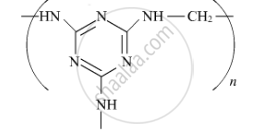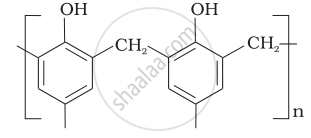Advertisements
Advertisements
प्रश्न
Attempt the following:
Write preparation, properties and uses of Teflon.
उत्तर
Preparation of teflon:
- The monomer used in preparation of teflon is tetrafluoroethylene, (CF2 = CF2), which is a gas at room temperature.
- Tetrafluoroethylene is polymerized by using free-radical initiators such as hydrogen peroxide or ammonium persulphate at high pressure to produce polytetrafluoroethylene (teflon).
\[\ce{\underset{Tetrafluoroethylene}{{n} CF2 = CF2}->[Polymerization][Peroxide]\underset{Teflon}{[-CF2 - CF2 -]}_{n}}\]
Properties of teflon:
- Teflon is tough, chemically inert and resistant to heat and attack by corrosive reagents.
- C – F bond is very difficult to break and remains unaffected by corrosive alkali, organic solvents.
Uses: Teflon is used in making non-stick cookware, oil seals, gaskets, etc.
संबंधित प्रश्न
Write the reactions involved in the preparation of PVC
Explain the following term: Homopolymers
Write the structure of melamine.
Write the monomers of the following polymer :

Answer the following in one sentence.
Identify 'B' in the following reaction:
\[\ce{H2N -(CH2)6 - NH2 + HOOC - (CH2)4 - COOH ->[N2][533 K]}\]'B'
Answer the following in one sentence.
Define the term: Vulcanization
Answer the following in one sentence.
Identify thermoplastic and thermosetting plastic from the following:
- PET
- Urea formaldehyde resin
- Polythene
- Phenol formaldehyde resin
Answer the following.
Write the reaction of the formation of Nylon 6.
Answer the following.
Write the reaction of the formation of Terylene.
Answer the following.
Match the following pairs:
| Name of polymer | Monomer |
| 1. Teflon | a. CH2 = CH2 |
| 2. PVC | b. CF2 = CF2 |
| 3. Polyester | c. CH2 = CHCl |
| 4. Polythene | d. C6H5OH and HCHO |
| 5. Bakelite | e. Dicarboxylic acid and polyhydoxyglycol |
Draw the structures of polymers formed from the following monomers
\[\ce{n HOOC–R–COOH + n HO–R'–OH}\]
Answer the following.
Write name and formula of raw material from which bakelite is made.
Identify condensation polymers and addition polymers from the following.
-(CO(CH2)4 - CONH(CH2)6NH-)n
Attempt the following:
Write the chemical reactions involved in the manufacture of Nylon 6,6.
Attempt the following:
Explain the vulcanisation of rubber. Which vulcanizing agents are used for the following synthetic rubber?
a. Neoprene
b. Buna-N
Nylon 6, 6 is a condensation polymer of hexamethylenediamine and _____________
Write chemical reactions for the preparation of high-density polythene.
Write two uses and two properties of polythene.
Explain vulcanization of rubber.
Which among the following polymers is obtained from styrene and 1-3-butadiene?
Identify the CORRECT statement regarding the following polymer.
\[\begin{array}{cc}
\phantom{....}\ce{O}\phantom{............}\ce{O}\phantom{...................}\ce{H}\phantom{.....}\\
\phantom{....}||\phantom{.............}||\phantom{...................}|\phantom{......}\\
\ce{-[C - (CH2)4 - C - NH - (CH2)6 - N -]_{{n}}}
\end{array}\]
The INCORRECT match for the polymer with its application is:
Identify the INCORRECT match.
\[\ce{{n} CH2 = CH2 ->[333 K - 343 K][6 - 7 atm, catalyst] X}\]
Which of the following is CORRECT about polymer 'X'?
Which of the following polymers is a heteropolymer?
Which of the following monomers is used in the manufacture of Neoprene rubber?
Which of the following pair of compounds is used as monomers for bakelite?
Which of the following polymer is used to make blankets?
Which of the following polymers is used as insulation for cables?
Name the polymers used in laminated sheets and give the name of monomeric units involved in its formation.
Match the polymers given in Column I with their repeating units given in Column II.
| Column I | Column II |
| (i) Acrilan |
(a) \[\begin{array}{cc} |
| (ii) Polystyrene | (b) \[\begin{array}{cc} \ce{Cl}\phantom{.......}\\ |\phantom{........}\\ \phantom{}\ce{-(CH2 - C = CH - CH2)\underset{n}{-}} \end{array}\] |
| (iii) Neoprene | (c) \[\begin{array}{cc} \phantom{................................}\ce{CN}\\ \phantom{..............................}|\\ \ce{-(CH2 - CH = CH - CH2 - CH2 - CH)\underset{n}{-}} \end{array}\] |
| (iv) Novolac | (d) \[\begin{array}{cc} \ce{-(CH2 - CH)\underset{n}{-}}\\ \phantom{.....}|\\ \phantom{.......}\ce{CN} \end{array}\] |
| (v) Buna—N | (e)  |
| (f) \[\begin{array}{cc} \ce{-(CH2 - CH)\underset{n}{-}}\\ \phantom{.....}|\\ \phantom{......}\ce{Cl} \end{array}\] |
The monomer of Teflon is ______.
Which of the following polymer has ester linkage?
Which one of the following polymers are prepared by addition polymerization?
Polymer used in bullet proof glass is ______.
Which of the following polymers do not involve cross linkages?
Which of the following polymer is used for manufacturing of buckets, dustbins, pipes, etc?
Identify the monomer used to prepare neoprene.
Which of the following is a polymer of enzyme?
Answer the following.
Write the structure of isoprene and the polymer obtained from it.
Write the preparation of viscose rayon.
Match the following pairs:
| Polymer | Monomer | ||
| (i) | Teflon | (a) | CH2 = CH2 |
| (ii) | PVC | (b) | CF2 = CF2 |
| (iii) | Natural rubber | (c) | Isoprene |
| (iv) | Polythene | (d) | H2C=CHCl |
Name and draw the structure of the repeating unit in natural rubber.
Write the structure of isoprene and the polymer obtained from it.
Name and draw the structure of the repeating unit in natural rubber.
Write the structure of isoprene and the polymer obtained from it.
Write the structure of isoprene and the polymer obtained from it.
Name and draw structure of the repeating unit in natural rubber.
Name and draw structure of the repeating unit in natural rubber.
Write the structure of isoprene and the polymer obtained from it.
Name and draw structure of the repeating unit in natural rubber.
Write the structure of isoprene and the polymer obtained from it.
